Overview
This article provides a comprehensive comparison of five free voting apps tailored for groups, emphasizing their distinct features and security measures. Each app presents unique strengths; for instance, Election Runner boasts a user-friendly interface, while ElectionBuddy is recognized for its robust security protocols. Furthermore, Votem emerges as a particularly innovative option, significantly enhancing accessibility and participation. This makes Votem a standout choice for organizations that seek effective electoral processes. By understanding these options, union leadership can make informed decisions that best suit their electoral needs.
Introduction
The emergence of free voting apps for groups signifies a pivotal transformation in organizational decision-making, fostering enhanced engagement and inclusivity among stakeholders. These innovative platforms not only streamline the polling process but also bolster accessibility and security, facilitating participation for all, regardless of their location.
Yet, with a plethora of options available, how can organizations determine the most suitable app that effectively balances features, security, and user experience? This article embarks on a comparative analysis of the leading free voting platforms, examining their distinct offerings and potential limitations to empower organizations in making informed choices.
Overview of Free Voting Apps for Groups
Free polling applications, such as a voting app for groups free, have emerged as essential tools for organizations aiming to enhance decision-making. These systems empower individuals to quickly create polls or elections through a voting app for groups free, promoting active participation from stakeholders regardless of their geographical location. The company distinguishes itself with its innovative online voting solutions, particularly the CastIron system, which significantly improves accessibility, security, and participation. This platform accommodates various election types and governance needs, rendering it a versatile option for organizations.
While alternatives like Election Runner and ElectionBuddy offer user-friendly interfaces and transparency, the unique features of the CastIron system, including its voting app for groups free, notably boost participation rates. Organizations utilizing this platform have reported participation rates reaching as high as 100%, underscoring the positive impact these applications have on voter engagement. The successful implementation of the company’s solutions in diverse settings, such as the Multnomah County Democrats’ internal elections, illustrates their effectiveness in fostering inclusive decision-making.
As industry leaders highlight the importance of modern electoral solutions, understanding Votem’s mission for accessible, secure, and transparent elections becomes crucial for organizations striving to enhance engagement and efficiency in their electoral processes.
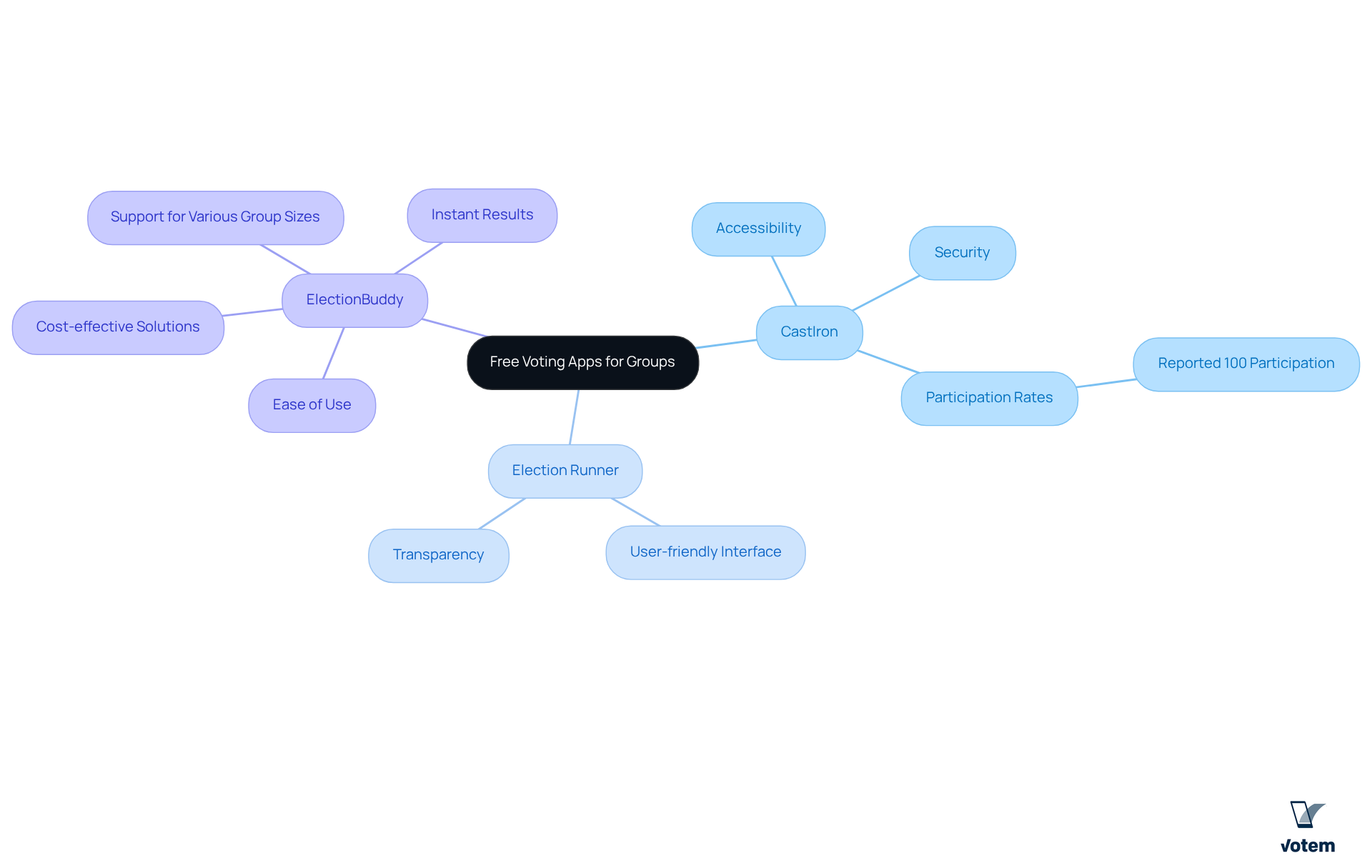
Feature Comparison of Top Voting Platforms
When evaluating the features of leading voting platforms, several critical aspects stand out that organizations must consider:
-
Election Runner: Celebrated for its intuitive interface, this platform enables quick setup and voting across devices. It supports various ballot methods, including ranked-choice systems, enhancing flexibility for organizations.
-
ElectionBuddy: Renowned for its strong security measures, ElectionBuddy provides anonymous ballot options and comprehensive reporting capabilities. This makes it particularly appealing for organizations that prioritize transparency and data integrity in their electoral processes.
-
Simply Voting: Focusing on accessibility, Simply Voting ensures that all members, including those with disabilities, can participate fully. It features customizable ballots and provides real-time results, which are crucial for timely decision-making.
Each system presents unique benefits, highlighting the necessity for organizations to assess their particular needs in relation to these characteristics to choose the most appropriate option.
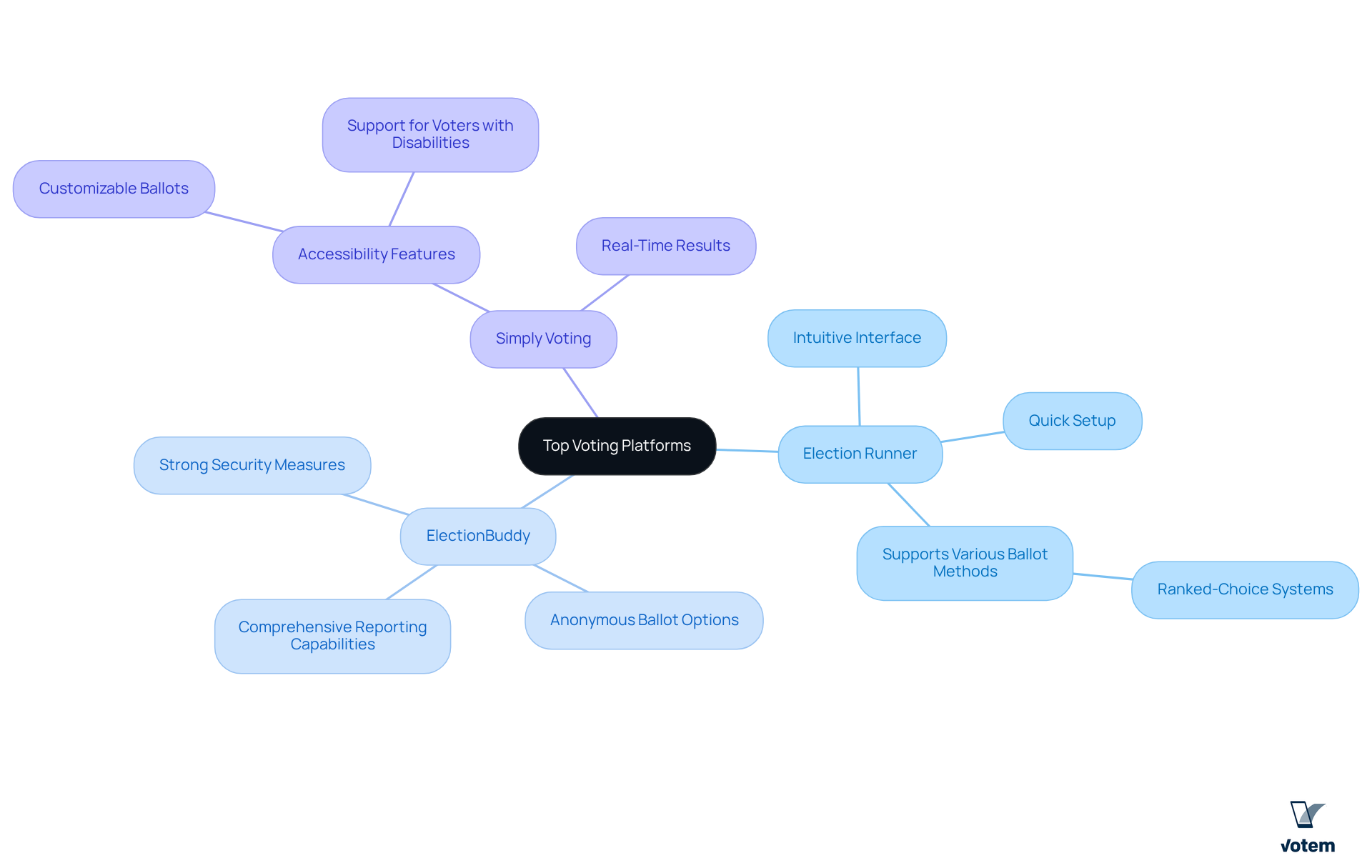
Security and Compliance Analysis
Security and compliance are paramount in online ballot systems, capturing the attention of organizations that prioritize the integrity of the voting process. Each platform employs various measures to protect voter information and ensure reliability.
Election Runner implements SSL encryption and offers an audit trail to track votes, ensuring both transparency and security. Furthermore, ElectionBuddy complies with international security standards, including GDPR, providing features like two-factor authentication to enhance security. In addition, Simply Voting concentrates on adherence to regulations such as NCUA and DOL, ensuring that all ballot processes meet legal requirements.
Votem stands out for its groundbreaking digital ballot systems, significantly improving accessibility for all eligible participants, including military personnel and individuals with disabilities. As noted by Linda McCulloch, ‘Implementing the new, modern system which allowed greater access for all qualified individuals from military personnel to those with disabilities was my greatest accomplishment in office.’ Votem has successfully managed large-scale electoral events, such as the National Radio Hall of Fame, where they handled 299,000 votes, an increase from 126,000 the previous year. Their system showcases strong security protocols that safeguard election data and guarantee a reliable electoral process.
Organizations must consider these security features when choosing a ballot system, as they directly affect public trust and election results. By understanding the importance of these measures, union leadership can make informed decisions that enhance the electoral process and uphold democratic values.
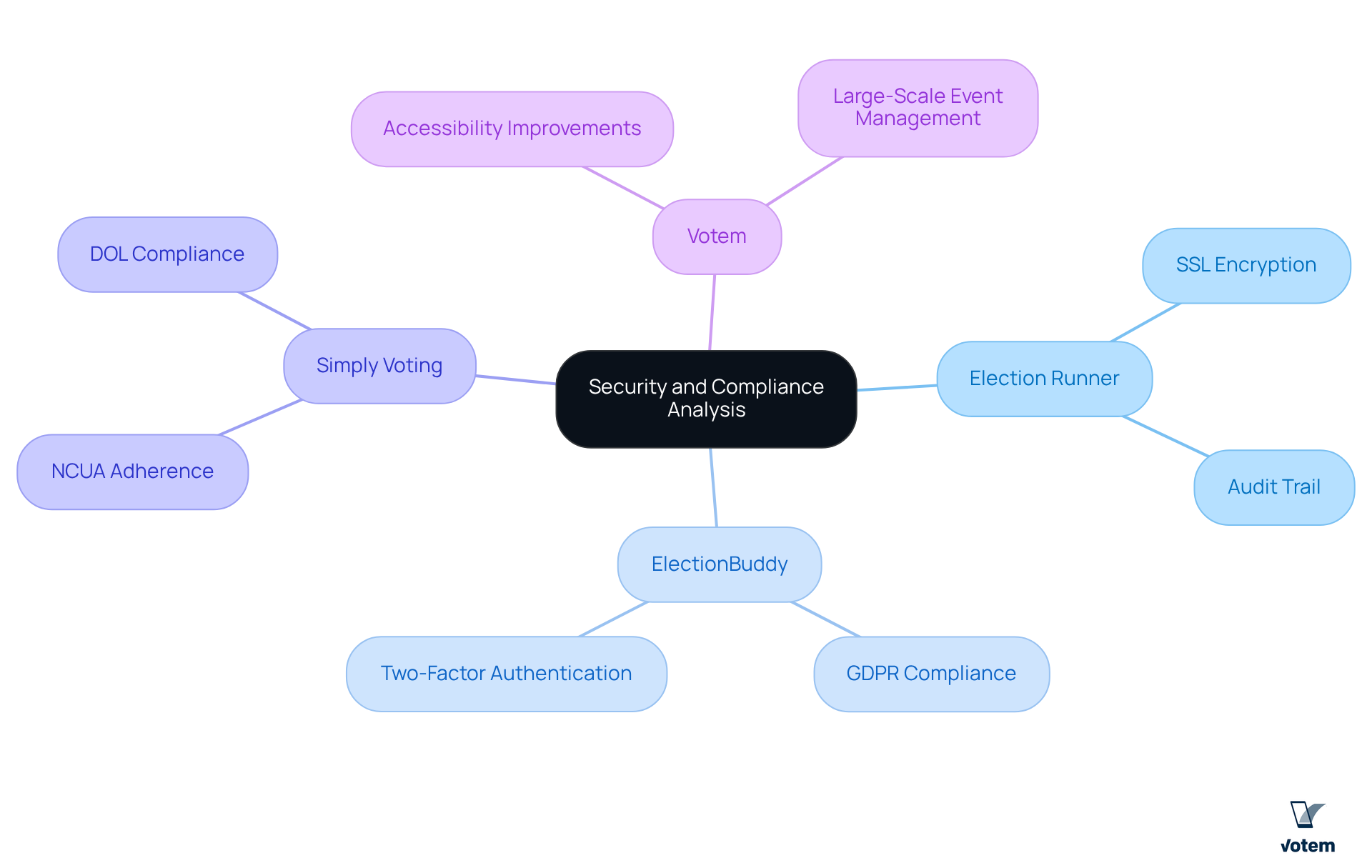
User Experience and Accessibility Evaluation
User experience and accessibility are critical components of any electoral platform, particularly in a voting app for groups free, as they directly influence participation rates. A seamless experience not only encourages engagement but also ensures that every eligible voter can make their voice heard through a voting app for groups free.
Election Runner stands out with its mobile-friendly design, allowing users to vote effortlessly from their smartphones or tablets. This feature enhances accessibility, making a voting app for groups free essential for on-the-go balloting and ensuring that voters can conveniently participate.
ElectionBuddy provides a straightforward interface that expertly guides users through the voting process. This design caters to individuals of all tech-savviness levels, demonstrating that intuitive systems can significantly reduce confusion and enhance engagement, as shown through user testing.
Simply Voting prioritizes accessibility by strictly adhering to WCAG 2.1 AA standards, ensuring that users with disabilities can navigate the platform without barriers. This commitment reflects a broader trend in election technology aimed at fostering inclusivity.
Furthermore, the company’s innovative online voting solutions enhance both accessibility and security, ensuring that all eligible participants—including military personnel and individuals with disabilities—can engage in elections. Testimonials from satisfied users underscore Votem’s efficacy: “Implementing Votem’s new, modern system, which allowed greater access for all qualified individuals, from military personnel to those with disabilities, was my greatest accomplishment in office.” By focusing on user experience and accessibility, these platforms can significantly increase voter turnout and engagement with a voting app for groups free.
Statistics reveal that over 2 million individuals were prevented from participating in elections due to long wait times, highlighting the urgent need for efficient and accessible electoral solutions. Incorporating user feedback and adhering to established standards not only fosters higher participation but also builds trust in the electoral process.
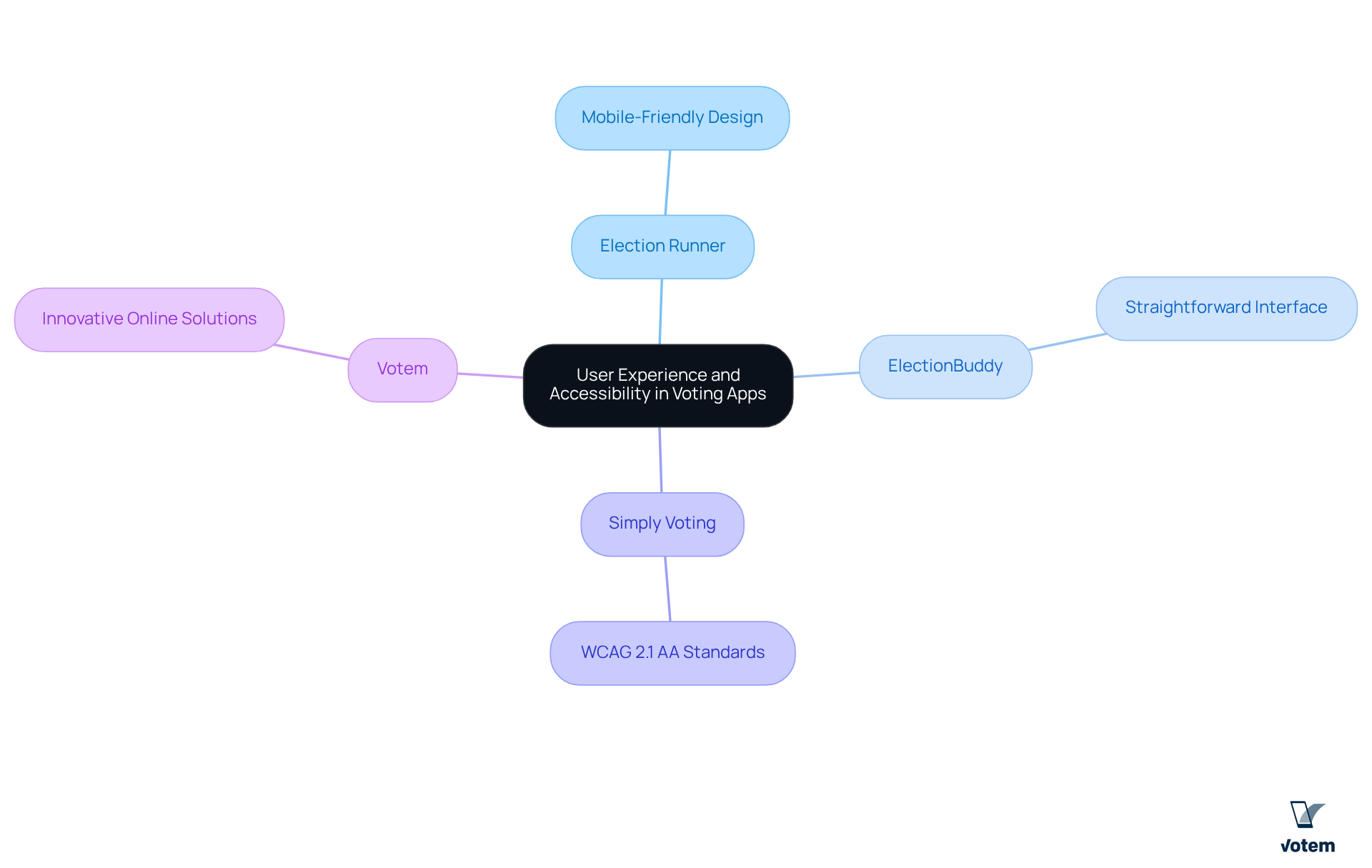
Pros and Cons of Each Voting App
Each voting app for groups free has distinct strengths and weaknesses that can significantly influence an organization’s choice.
Election Runner stands out with its user-friendly interface, quick setup, and mobile compatibility. However, it may fall short in advanced security features compared to its competitors.
ElectionBuddy is recognized for its robust security measures, detailed reporting capabilities, and anonymous voting options, yet its complexity might pose challenges for users who are not tech-savvy.
Simply Voting excels in high accessibility standards and customizable ballots, but pricing could be a concern for smaller organizations.
Votem has implemented a modern system that enhances access for all qualified voters, including military and disabled individuals. Notably, it successfully managed the receipt of 299,000 votes for the National Radio Hall of Fame, demonstrating significant voter engagement. Furthermore, it has received positive feedback from the New Mexico State Republican Party regarding its performance and future election plans. Nevertheless, as a newer solution, some organizations may require time to adapt to its features, potentially facing a learning curve with its advanced functionalities.
Understanding these pros and cons equips organizations to make informed decisions tailored to their specific needs and resources.
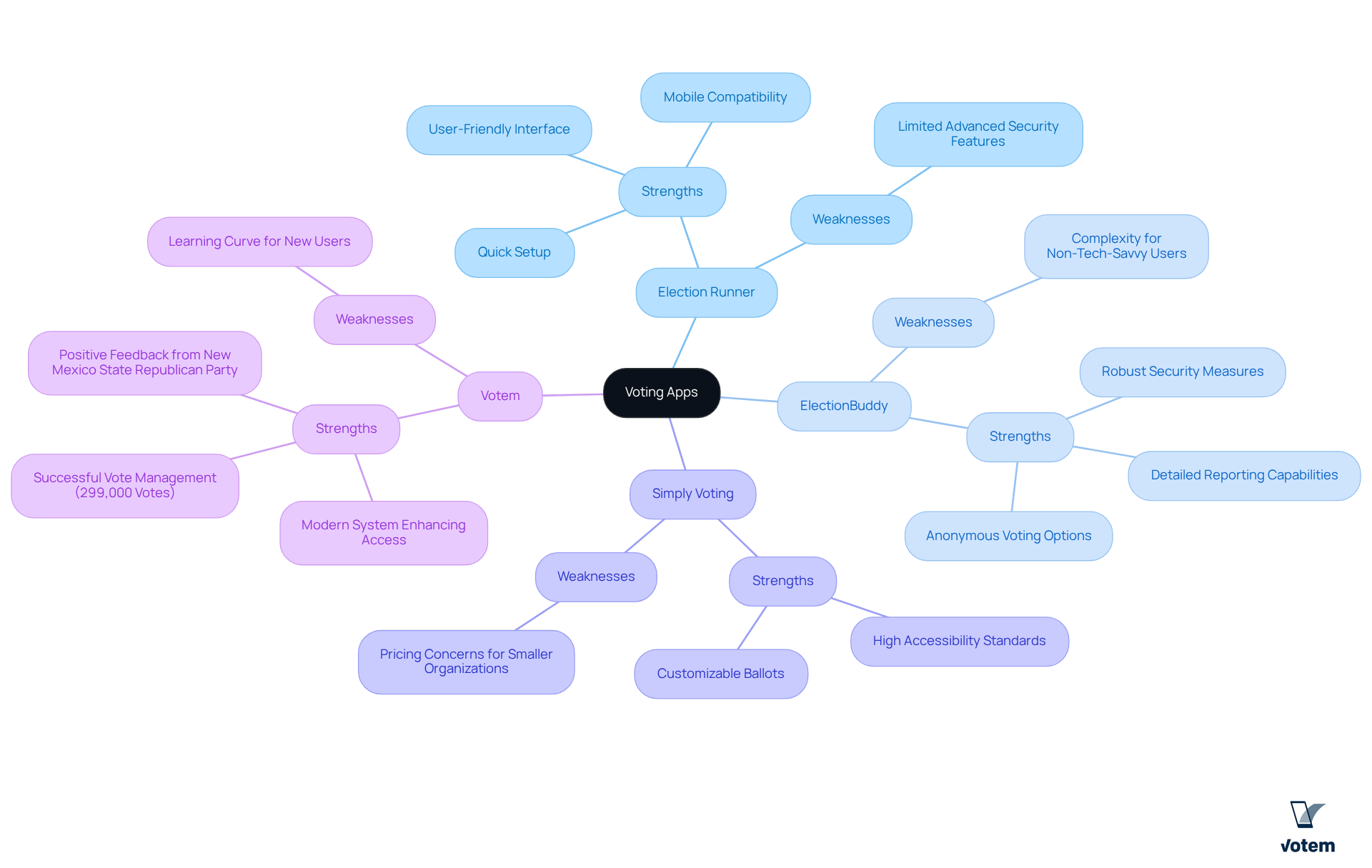
Conclusion
The exploration of free voting apps for groups highlights their crucial role in enhancing organizational decision-making processes. By leveraging these innovative platforms, groups can foster greater engagement and inclusivity, ensuring that every voice is heard, regardless of geographical constraints. The emphasis on accessibility, security, and user experience underscores the necessity for organizations to adopt modern voting solutions that resonate with their specific needs.
Key features of prominent voting apps such as Election Runner, ElectionBuddy, Simply Voting, and Votem have been examined. Each platform presents unique advantages, from user-friendly interfaces and robust security measures to high accessibility standards. This comparison highlights the varied strengths and weaknesses of these applications, guiding organizations in making informed decisions tailored to their operational requirements.
Given the significant impact these voting apps can have on participation rates and overall electoral integrity, it is imperative for organizations to prioritize their selection process. By embracing the right tools, groups can streamline their decision-making while reinforcing democratic values and enhancing trust in the electoral process. As the landscape of voting technology continues to evolve, staying informed about the best options available is essential for fostering effective and inclusive governance.
Frequently Asked Questions
What are free voting apps for groups?
Free voting apps for groups are tools designed to facilitate decision-making by allowing individuals to create polls or elections easily, encouraging participation from stakeholders regardless of their location.
What is the CastIron system?
The CastIron system is an innovative online voting solution that enhances accessibility, security, and participation in elections. It accommodates various election types and governance needs, making it a versatile option for organizations.
How do participation rates compare among different voting platforms?
Organizations using the CastIron system have reported participation rates as high as 100%, indicating its effectiveness in boosting voter engagement compared to other platforms.
What are some alternative voting platforms mentioned in the article?
Alternatives mentioned include Election Runner, known for its user-friendly interface and quick setup, and ElectionBuddy, recognized for its strong security measures and transparency.
What features does Election Runner offer?
Election Runner features an intuitive interface that allows for quick setup and voting across devices, supporting various ballot methods, including ranked-choice systems.
What makes ElectionBuddy a preferred choice for some organizations?
ElectionBuddy is favored for its strong security measures, offering anonymous ballot options and comprehensive reporting capabilities, which are important for organizations focused on transparency and data integrity.
How does Simply Voting ensure accessibility?
Simply Voting focuses on accessibility by allowing all members, including those with disabilities, to participate fully. It offers customizable ballots and provides real-time results for timely decision-making.
Why is it important for organizations to evaluate voting platforms?
Organizations need to assess their specific needs in relation to the features of various voting platforms to choose the most appropriate option that meets their governance and electoral requirements.
List of Sources
- Overview of Free Voting Apps for Groups
- Free Online Election Tool: The Features and Benefits of ElectionBuddy’s Voting Software – ElectionBuddy (https://electionbuddy.com/free-elections)
- Case Studies (https://starvoting.org/case_studies)
- Not for Profits, NGOs, societies, charities and clubs – ElectionBuddy (https://electionbuddy.com/customers/not-for-profits-ngos-societies-charities-clubs)
- Create an Online Electronic Vote for Your Business (https://voteer.com/online-voting/business)
- Feature Comparison of Top Voting Platforms
- 16 Best Online Voting Software for 2025 | Appvizer (https://appvizer.com/operations/online-voting-tools)
- Best Voting Software with Reporting & Statistics 2025 (https://getapp.com/collaboration-software/voting/f/reporting-statistics)
- User Experience and Accessibility Evaluation
- The UX Implication of a Voting System (https://uxplanet.org/the-ux-implication-of-a-voting-system-4d41b612b4fc)
- Improving Voter Experience Through User Testing and Iterative Design – JUX (https://uxpajournal.org/voter-experience-user-testing-iterative-design)

